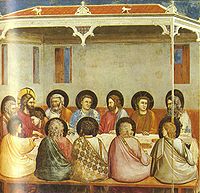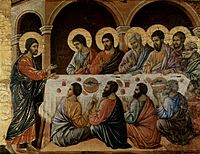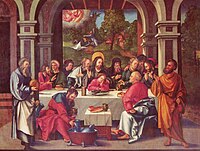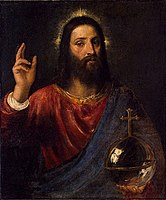
Halo (religious iconography)
A halo (from Ancient Greek ἅλως (hálōs) 'threshing floor, disk';[1][2] also called a nimbus, aureole, glory, or gloriole (Latin: gloriola, lit. 'little glory') is a crown of light rays, circle or disk of light[3] that surrounds a person in works of art. The halo occurs in the iconography of many religions to indicate holy or sacred figures, and has at various periods also been used in images of rulers and heroes. In the religious art of Ancient Greece, Ancient Rome, Christianity, Hinduism, and Buddhism (among other religions), sacred persons may be depicted with a halo in the form of a circular glow, or flames in Asian art, around the head or around the whole body—this last form is often called a mandorla. Halos may be shown as almost any colour or combination of colours, but are most often depicted as golden, yellow or white (when representing light) or as red (when representing flames).
For other uses, see Halo (disambiguation).Ancient Mesopotamia and Persia[edit]
Sumerian religious literature frequently speaks of melam (melammu in Akkadian), a "brilliant, visible glamour which is exuded by gods, heroes, sometimes by kings, and also by temples of great holiness and by gods' symbols and emblems."[4]
Persian mythology, and later Zoroastrian philosophy, speaks of the similar concept of Khvarenah (later farrah), a divine, radiant power that sanctified a king and his reign. It was most often depicted as a phoenix-like bird, the Simurgh.

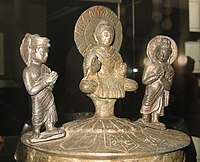

![Chola Nataraja with an aureole of flames (11th century)[21]](http://upload.wikimedia.org/wikipedia/commons/thumb/8/81/Shiva_Nataraja_Mus%C3%A9e_Guimet_25971.jpg/178px-Shiva_Nataraja_Mus%C3%A9e_Guimet_25971.jpg)








